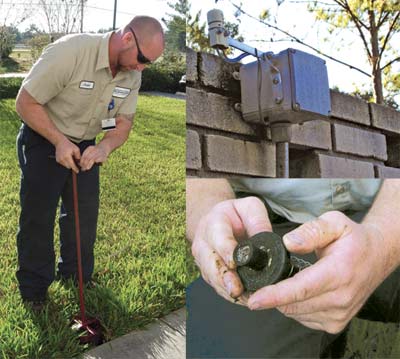 Jason DiBattista, District tradesworker, inspects the sprinkler heads at the District each month, cleaning in and around them. The District’s rain sensor device overrides the irrigation timer if there has been enough rain.
Jason DiBattista, District tradesworker, inspects the sprinkler heads at the District each month, cleaning in and around them. The District’s rain sensor device overrides the irrigation timer if there has been enough rain.
Making sure your irrigation system is operating effectively and efficiently is always important, but it is even more critical during periods of drought when water restrictions are tighter.
Here are a few simple ways to check your irrigation system. Some of the repairs may require hiring an irrigation professional.
Inspect Your Irrigation System
Manually start your irrigation system for each zone on your irrigation day to check for leaks, broken pipes, damaged or tilted sprinkler heads, blocked sprinkler patterns and overspray onto impermeable surfaces such as roads and sidewalks.
Check for soft, wet spots that are always around the inground sprinkler head. These spots could indicate a leak that is being absorbed into the ground. Contact your irrigation maintenance specialist if repairs are needed.
Look for dry spots. They are a sign of one of the following: the sprinklers may be placed too far apart; the water pressure is low; sprinkler patterns may be blocked by overgrown grass; shrubs or low-hanging limbs may be blocking the sprinklers; or the screens inside the sprinklers are clogged.
Adjust, move or add sprinkler heads if your current sprinklers do not throw water 80 to 100 percent of the distance to the adjacent sprinkler.
Rain Shutoff Devices
If you have an automatic sprinkler system, be sure it is equipped with a working rain shutoff device to override the system when enough rain has fallen. As water evaporates from the device, the irrigation system will resume normal operation. Rain shutoff devices are required by Florida law on all automatic irrigation systems installed since 1991.
Make sure the rain shutoff device is located away from overhead obstructions, with a clear view of the sky and at least five feet away from air-conditioning units or pool heaters.
Check the rain shutoff device regularly to ensure the device is working properly and that the corresponding switch in the control box is set at “on.” Test the device by wetting the sensor to verify the system won’t operate when the controller is turned on.
Adjust the sensor to interrupt irrigation after a half inch of rain. If there is a vent ring located just below the cap, the vent can be closed or partially closed to restrict air flow through the discs. Make sure the vent is closed so it will allow the disks to dry more slowly, thus keeping the system off for a longer period of time. This adjustment is used to compensate for an “overly sunny” location.
To learn more about how to create and maintain water-conserving Florida-friendly landscapes, please contact the Florida Yards & Neighborhoods coordinator in your area. Coordinator contact information can be found on the District’s web site at WaterMatters.org/yards/.
